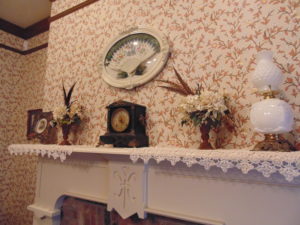Members, please join us on Friday, November 21st, 11:30am-12:30pm, in our exhibit, At Home With the Harns to talk about how you can display and use your collection in your home. We will also share tips on best ways to incorporate your treasures into your holiday decorating scheme.
Reservations are required for this event. Please R.S.V.P. to Matt McKay (904) 829-0745 ext. 218 or mmckay[at]staugustinelighthouse.org by Nov. 18th.
Your antiques, art and other collections reflect your personality and interests and add warmth and style to your surroundings. Display them with pride but be responsible. There are a few rules that will help you decorate your home with your unique possessions while keeping them safe.
 Avoid fluctuations in temperature and humidity. A humidity level of 45-50% is ideal for most items but a stable level even above or below this is better than one that changes frequently. Keeping objects away from drafts or heat registers and A/C vents is best. When hanging framed items, avoid outer walls and use spacers or “bumpers”, available in the framing department of art, hardware and craft stores, to keep a small air space between the back of the piece and the wall. This will help keep the humidity and temperature levels more constant.
Avoid fluctuations in temperature and humidity. A humidity level of 45-50% is ideal for most items but a stable level even above or below this is better than one that changes frequently. Keeping objects away from drafts or heat registers and A/C vents is best. When hanging framed items, avoid outer walls and use spacers or “bumpers”, available in the framing department of art, hardware and craft stores, to keep a small air space between the back of the piece and the wall. This will help keep the humidity and temperature levels more constant.
Before you put your copper bowl, lace doilies or rubber duck collection in that antique oak cabinet, be sure there is a barrier coating inside. Wood, especially oak, can emit chemicals and acids that are not harmful to you but can damage paper, fabric, metal and plastics. A simple coat of clear polyurethane or white latex paint to all inside surfaces can prevent this.
Also be sure all frames and enclosures are made of archival materials. Most craft stores now carry archival supplies in their scrapbooking and framing sections. A piece of clear Mylar placed under objects on shelves can prevent damage from chemical reaction between the wood and other materials.
Sunlight is damaging to nearly everything, fading fabric, bleaching wood and causing chemical changes to paper and plastics. Windows can be covered with shades that cut out up to 99% of damaging UV rays and films may be applied to windows for the same purpose at little cost. Light damage is irreversible, so either live like a Victorian with drapes drawn 24/7 or let the sun shine in through your UV-protected windows.
Consider UV protected acrylic instead of glass in your frames and shadow boxes to block the sun and prevent damage if the piece should fall or be broken by an impact. Enclose very delicate pieces in Plexiglas cases to keep them dust-free. Dust attracts moisture, which causes corrosion and other problems.
Thoughtful placement and care can help you enjoy and share your treasures with family and guests while keeping them safe for future generations.
Click on the links below for tips from museum professionals:
- The Henry Ford Museum shares a comprehensive guide to caring for your personal collections, arranged by type and material
- The Library of Congress also has excellent advice on caring for family treasures and personal.
Kathleen McCormick has almost two decades of experience in museum conservation. She is currently the Director of Museum Conservation at the St. Augustine Lighthouse & Museum.
This article was originally published in The St. Augustine Record.

